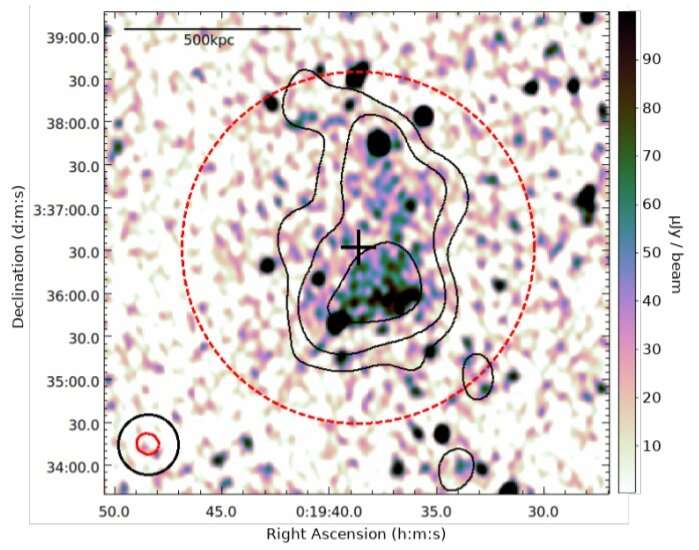November 17, 2021 report
Study sheds more light on the nature of galaxy cluster ACT-CL J0019.6+0336

An international team of astronomers has performed a multiwavelength study of a galaxy cluster known as ACT-CL J0019.6+0336 (J0019 for short). Results of the research, published November 8 on the arXiv pre-print repository, deliver more insights into the nature of this cluster.
Galaxy clusters contain up to thousands of galaxies bound together by gravity. They are the largest known gravitationally bound structures in the universe, and could serve as excellent laboratories for studying galaxy evolution and cosmology.
At a redshift of 0.266, J0019 is a very massive and energetic galaxy cluster with a mass of about 1,020 trillion solar masses and X-ray luminosity at a level of some 494 tredecillion erg/s. In order to shed more light on the properties, dynamics and morphology of J0019, a team of astronomers led by Denisha S. Pillay of University of KwaZulu-Natal in Durban, South Africa, took a closer multiwavelength view of this cluster.
Pillay's team has analyzed the optical, radio and X-ray data from the Atacama Cosmology Telescope (ACT), Dark Energy Survey (DES), MeerKAT telescope and ESA's XMM-Newton spacecraft.
"Multiwavelength observations of galaxy clusters carry an abundance of information, giving insight into the intracluster medium (ICM), its thermal and non-thermal components, and the cluster dynamics," the researchers explained.
The observations found that J0019 has two cluster components: one along the northwestern and another in the southeastern direction. The brightest cluster galaxy (BCG) of the main component lies in the southern region and the BCG of the infalling cluster lies in the northern region. The density map shows that J0019 is generally elongated and axisymmetric.
It turns out that there is a discrepancy between the Sunyaev–Zel'dovich (SZ) mass, X-ray mass, and dynamical mass of J0019 as these parameters were measured to be 1,020, 650 and 250 trillion solar masses, respectively. Moreover, the study revealed that there is a velocity offset of approximately 950 km/s between the mean velocity of the cluster and that of the BCG, suggesting that J0019 is a disturbed cluster.
The research also detected a low surface brightness radio halo in J0019. In general, radio halos are enormous regions of diffuse radio emission, usually found at the centers of massive galaxy clusters. The halo flux density of the cluster was estimated to be 9.16 mJy, while its calculated k-corrected 1.4 GHz radio power was found to be at a level of 1.0 YW/Hz.
According to the astronomers, the results indicate that J0019 is a merging cluster and probably is currently in a post-merging phase. They noted that the radio halo in J0019 would require a significantly substantial merger to power it.
The researchers added that future spectroscopic observations of the full field of J0019 are required in order to identify more cluster members, infer cluster dynamics, and to better understand the merging event.
More information: Denisha S. Pillay et al, A Multiwavelength Dynamical State Analysis of ACT-CL J0019.6+0336. arXiv:2111.04340v1 [astro-ph.HE], arxiv.org/abs/2111.04340
© 2021 Science X Network




















